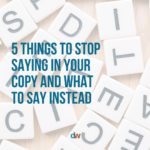5 Things To Stop Saying In Your Copy and What To Say Instead
As a copywriter, I firmly believe that your business is powered by words, but I also believe that you don’t have to hire a professional copywriter to write great words for you.
I mean, let’s face it: not everyone is at a point in their business where they can outsource and some people simply don’t want to, so the key is learning the skill of copywriting so that you can do it yourself and do it really well.
When you learn to write copy as a business owner, you give yourself a HUGE advantage.
Ultimately, I believe that ANYONE (and I really do mean anyone) can write great copy that converts, as long as you know how to do it.
The how of great copywriting comes from following a tried and true structure, using YOUR voice (meaning you aren’t trying to be someone else), and avoiding a few of the major mistakes that I see people make all the time in their copy.
5 Things To Stop Saying In Your Copy (And What To Say Instead)
- “Hey guys…”
Even though you might be writing to the masses, whether that’s through a blog post, email, or social media post, you want to make sure that your copy always FEELS like you’re writing to one person.
Because in actuality, ONE person will be reading your content… not a group of people.
Instead of leading your email, blog, Instagram story, or any other social media post with something like, “hey guys!” lead with the person’s name when you can (like in emails) and speak directly to them in the body of your copy.
If you’re creating other content where you can’t utilize names, make sure you stay away from phrases like:
“I know you are all thinking this…” ➡️ “I know YOU might be thinking this…”
“I wanted to share this with all of you…” ➡️ “I wanted to share this with YOU.”
See the difference?
You go from speaking to a group of people to speaking to one single person.
- “You’ve already tried this…”
This is one of the BIGGEST mistakes that I see people making in their copy and it’s really easy to fix.
You never, ever, ever want to make assumptions about your audience.
Even if you really do know their problems or how they’re feeling, you don’t want it to come off that way.
Instead, you want to give your audience an escape hatch by using words like “maybe” or “probably” and allow them to determine if that’s what they’re experiencing.
Here are a few examples:
“I know you feel like writing copy for your sales page is hard…” ➡️ “You might feel like writing copy for your sales page is hard…”
“You’ve already tried to write copy for your sales page and it didn’t work.” ➡️ “You’ve possibly already tried to write copy for your sales page and maybe you feel like it didn’t work.”
“You’re tired of trying to figure out how to write copy for your sales page.” ➡️ “You’re probably tired of trying to figure out how to write copy for your sales page.”
One small word makes a huge difference in the eyes of your reader!
- “Me,” “My,” and “I”
It should come as no surprise that people want to hear less about you and more about them.
And I get it! Talking about yourself is a natural thing to do, so it’s really easy for this to come through in your copy.
This is why I always encourage people to let their copy rest after writing and always come back to proofread later.
When you do, you’ll be able to more clearly identify places where you’re making the copy about you and not about them and you can implement the replace “I” with “you” strategy.
- Generalites
I know you probably hear people say “be specific” all the time, but it’s true – you want to be very specific in your copy.
The more specific you are, the more universal you actually become and it’s a beautiful thing!
It’s usually very tempting to just use generalities in your writing, because you might think that more people will relate to what you’re saying.
But when you choose generalities over specificity, you end up talking to no one.
Generalities are what people see all the time and it’s the language that they tune out. But specificity, on the other hand, grabs their attention and keeps them reading.
For example, my program LaunchFlow Accelerator was designed to help people plan and execute their launches with ease.
I *could* say just that, but what I say instead is, “LaunchFlow Accelerator is a 6-week experience to cut through the noise and create fun, repeatable, profitable launches that fill your programs WITHOUT burnout.”
“With ease” is something that people say all the time about many different things.
The specificity that I lead with in the sales page copy helps the program stand out and it speaks to what people really desire.
- “You should…”
This one is a big no-no in copywriting, because the fact of the matter is that NO ONE wants to be told what to do.
The moment I read something that says “you should do xyz” I usually tune it out or keep scrolling.
When people use “should” statements in their copy, they usually have great intentions, but they often don’t realize that it’s doing more harm than good.
Here’s why: the definition of the word “should” shines some light onto why this word is typically triggering.
“Used to indicate obligation, duty, or correctness, typically when criticizing someone’s actions.”
Note the cord criticize… that’s not how you want your audience to feel, right?
Instead, you want to guide them into a solution with your words, not push or force them into something.
Here’s what this often looks like in copy:
“If you want to stop experiencing [problem], you should try [solution.]” ➡️ [If you’re currently experiencing [problem], [solution] can help you experience [desire.]
In the second sentence, you help them see what’s possible with your solution instead of making it feel like it’s something they should do.
Copywriting Resources
Want more copywriting tips like this? You’re in the right place!
Even if you consider yourself to be a “bad writer,” I want you to know that you can learn the skill of copywriting to generate results in your business.
In fact, it’s really a non-negotiable in business – without the right words, your message likely won’t connect with your audience and you’ll be stuck wondering why no one is buying.
To help you build your copy confidence, there’s a few resources you can grab to start honing this skill today:
- The DW Copy Blog – here you’ll find new blog posts weekly about all things copy, launching, and email marketing
- Inbox Love Mini Course – the 14 day mini-course that helps you write irresistible emails that your clients love to open, read and buy
- 90-minute 1:1 Epiphany Sessions – tune up your copy with a copy expert (it’s me!) in just 90 minutes so you can confidently publish and send
And if you want daily tips, tricks, and strategies make sure you follow along on Instagram or connect with me on LinkedIn!


Great word swaps, Danielle! Love this!!